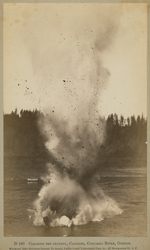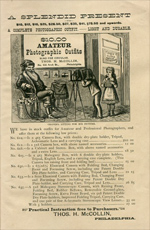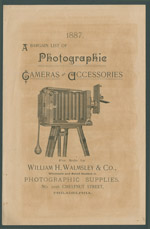Towards Modern Photography
Despite the many innovations from 1839 through the 1870s, photography remained an expensive and cumbersome process. The best process during this period was still the wet plate collodion, which had to be prepared, exposed and processed on site, all within an hour before the plate dried. Consumption of photography had become accessible to the masses, but creating photographs was still reserved primarily for professionals.
The next fifteen years would bring a series of advances that industrialized and democratized the production of photographs. The most important of these developments was the use of gelatin as a binder for both positives and negatives. First came the invention of the dry-plate negative, which employed gelatin instead of collodion as the medium used to bind light-sensitive chemicals to glass plates. Suggested by Richard Maddox in 1871 and developed for broad use in 1878, the dry-plate negative allowed photographers to buy prepared plates and expose them at their convenience. Dry plates allowed faster exposure times, making it possible to capture events and objects in motion (such as the explosion seen in this case). By the late 1880s the dry plate process became the norm.
Later, in the 1880s, gelatin printing out paper replaced albumen (egg whites) with gelatin as the substance binding light-sensitive chemicals to paper. Gelatin paper improved the quality of paper prints and remained the standard for printing until the digital era.
At the same time, George Eastman (1854-1932) began experimenting with flexible film as an alternative to glass plates. In 1889 he introduced a Kodak camera that used a roll of plastic negatives—the modern “roll of film.” The camera’s slogan: “You push the button, we do the rest.”
All the elements for a new phase of the photography revolution were in place. Photography was now accessible to the masses. Cameras were portable. Film was fast. The new term snapshot captured the ease and speed of the nascent technology. It was possible to shoot photographs on the go, documenting personal travel, private events, and ordinary life experience.
 |
Carleton E. Watkins. “Clearing The Channel,” ca. 1882. [zoom] Albumen print, 7 ¾ x 4 ¾ in. This is a photograph documenting the clearing of the channel of the Cascades of the Columbia River in Oregon by dynamite explosion. The image demonstrates the new possibilities brought by the gelatin dry-plate glass negative. Conveniently manufactured by a third party, the gelatin negative allowed for a sufficiently fast exposure time to capture exploded rock fragments in mid-flight. |
 |
“Photography for Ladies.” Henry Clay Price. How to Make Pictures: Easy Lessons for the Amateur Photographer. NY: Scovill Manufacturing Co. 1882. [zoom]
This amateur manual boasts that the new “pocket camera” is ideal for the “gentler sex.” The “tyrant man” will not be needed to carry about the simple-to-use device weighing only 3 ¾ pounds. An advertisement printed at the end of this book notes: “The introduction of Dry Plates and the impetus given them to the cause of Amateur Photography, created demand for light and compact apparatus that could be easily carried about.” |
 |
“A Splendid Present.” American Journal of Photography and Photographers Price Current. Philadelphia, March 1884. [zoom]
By the 1880s, “light and durable” amateur photography outfits were available for only $10. This advertisement suggests that photography is now so simple that even a child can use a camera. |
 |
A Bargain List of Photographic Cameras and Accessories for Sale by William H. Walmsley & Co. Philadelphia, 1887. [zoom] |
 |
“You press the button, we do the rest.” The Pocket Kodak. Made by Eastman Kodak Co., Rochester, NY, patented May 5, 1885, August 6, 1889 [zoom]
The Pocket Kodak revolutionized photography. Instead of changing a plate after each shot, the photographer made multiple exposures on a roll of film and advanced frames by turning a knob. A lever released a shutter where once the lens cap had to be removed and replaced by hand. Most importantly, the camera came preloaded with film for 100 photographs. The amateur photographer then mailed in the camera for developing, printing, and reloading for another round of photographs. |